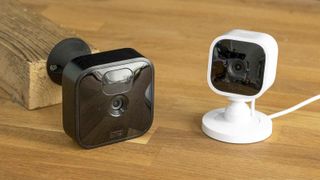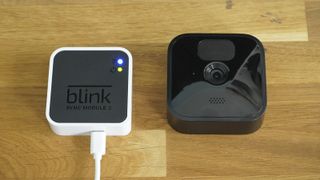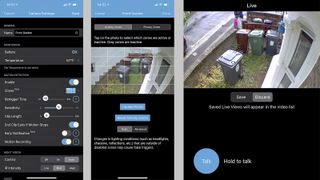Digital Camera World Verdict
The Blink Outdoor offers a sensibly priced entrance into home security which lets you monitor your property and even speak back. It scores by being incredibly easy to install, and by offering the option of subscription-free use (though cloud storage is clearly Blink’s preference). It could be a bit quicker on the draw, and the battery life is a worry, but the design and construction are great and in targeted spots it’ll do well.
Pros
- +
Easy to set-up and install
- +
Option to store clips to USB drive
- +
30-fps video is smoother than many security cameras
- +
Package includes setup tools and mount
Cons
- -
Some latency in triggering recordings
- -
Battery life difficult to predict
- -
Deliberate feature restriction if you don't subscribe
- -
Sync Module 2 not compatible with older Blink XT/XT2
Why you can trust Digital Camera World
The Blink series of home security cameras were always built with ease of use and practicality in mind, and since Amazon acquired the firm in 2017 they have done a good job of living up to that (especially if your preferred digital assistant is Alexa). While earlier models, the XT and XT2, featured built-in MicroUSB cards to record footage, the new Blink Outdoor (and its counterpart the Blink Indoor) send their video to a small hub which can record to a generic USB stick, and handle up to ten cameras.
Like other cameras built for the smart home era (e.g. Nest), users are expected to setup and check their video through an app and to be at least prepared to pay a small subscription fee for some features. Perhaps inspired by baby camera monitors, the other increasingly standard feature is two-way-talk; the ability to speak to whomever the camera can see, using your phone, and a built-in mic and speaker.
• See also Blink Mini review

Blink Outdoor: specifications
Resolution: 1080P
Field of View: 110˚ (diagonal)
Night Vision: Yes (Black & White)
Frame Rate: up to 30fps
Subscription Storage: Optional
Battery: 2 x Lithium AA (not rechargeable)
Ingress Protection: IP65
Operating Temperature: -20˚C – 45˚ C (-4˚ to 113˚F)
Dimensions: 71 x 71 x 31mm
Weight: 48g
Key features
The Blink Outdoor is all about installing a security camera system as painlessly as possible; you can have a functioning system up and running with nothing more than a couple of self-tapping screws, AA Lithium batteries, camera mount, and a “Sync Module 2” (a tiny indoor hub), all of which are in the box.
Once up and running, the camera features 2-way talk, motion sensors and alerts, not to mention Alexa integrations (and of course a phone app for live view). Clips can be recorded from the hub to a USB stick so subscription-free operation is possible.
The camera also boasts definable zones (to minimize false alerts), timelapse clips, a built-in thermometer and a good range of controls to help you make the most efficient use of your battery.
Build & handling

The Blink is quite a striking shape, the volume is small but it looks as big as any other camera from the front. Design critics may even draw a parallel with iPhone; a shiny front on a rectangle with rounded corners, though at 31mm thick the Blink is easier to rest on its base. For most purposes it’ll be better to use the mount, however, and you don’t have to be a DIY genius to fit the conical mount. Make sure it’s tight, though, as it takes a firm push to clip the camera to a ready mount, though the ball joint provides a good range of movement. (Since it takes a similar yank to remove it, make sure it’s not easy to reach).
Indoors the even lighter, smaller Sync Module, has a matt finish and feels a little cheap, but it’s not for display, it’s a discrete hub. The white edge trim stems from its ability to act as a hub for multiple Blinks, including the white-edged indoor cameras.
We were impressed with the straightforward nature of the setup process, and the quality of the on-screen guidance (setup is via iPhone or Android). It was especially nice to see that even when things go wrong the app is patient, offers suggestions, and they’re written in good English.

Blink Outdoor: Performance
In terms of video, the camera provides solid performance during daylight hours, though the night vision is somewhat blurry. The image does a good job of picking out detail and tone, with better white balance than many security cameras. The real issue is the latency. In our tests the camera was inconsistent at best in terms of triggering.
During the day it did spot and alert motion in the zone but by the time the recording was active the subject may be in retreat. At night, and on windy days, false alerts were more frequent despite a few attempts at reducing my activation zone (the feature is in Beta to be fair) however oddly latency seemed less of an issue.
Video clips: The daylight clip reveal the latency issue; the clip is not trimmed – the ‘bandit’ was already in retreat by the time the recording was activated.
It must be said that the built-in mic, while adequate for security, is also being taxed to its limits for 2-way talk. It picks up a lot of background noise, and the speaker is not easy to hear unless you’re within a couple of paces of the camera.
If you choose to use the USB recording only, and no subscription, video is recorded once a day (is it on Blink’s servers in the meantime?). You can review them in the Blink app but for some reason there are no thumbnails in the list of clips, just generic icons; playing is also ponderous, and there is no option to bulk delete (except of course plugging the USB stick into your computer).
Blink Outdoor: Verdict

Simplicity is great, but the flip-side is the limitations of low-power operation. If you choose to make more than a few seconds use of live-view a day, the battery life will be tumble, and the batteries aren’t rechargeable. The result is a camera better suited to positions than others – you can’t really place it somewhere a road is in shot, for example. For larger homes and gardens the system will be easier to position. The relatively narrow field-of-view will help with this – aiming up a path, for example.
The issues of cloudless operation feel planned into the development of the Blink app; it’s a bit too obvious they want to drive subscription sales. In full conspiracy theory mode, we could add that Amazon will no doubt do well from USB stick and Lithium battery sales too.
Grumbles aside, the Blink cameras do achieve the option of adding home security at a reasonable cost, and the recordings do go to a separate location without subscription. The choice on offer here is difficult to beat at this price (to see what a higher budget will offer, read our review of the rechargeable Arlo Pro 4). If the Ring Doorbell’s 24/7 feature could be added, it’d be perfect.
Read more:
Best indoor security cameras
The best video doorbell cameras
The best body cameras for personal security

With over 20 years of expertise as a tech journalist, Adam brings a wealth of knowledge across a vast number of product categories, including timelapse cameras, home security cameras, NVR cameras, photography books, webcams, 3D printers and 3D scanners, borescopes, radar detectors… and, above all, drones.
Adam is our resident expert on all aspects of camera drones and drone photography, from buying guides on the best choices for aerial photographers of all ability levels to the latest rules and regulations on piloting drones.
He is the author of a number of books including The Complete Guide to Drones, The Smart Smart Home Handbook, 101 Tips for DSLR Video and The Drone Pilot's Handbook.
